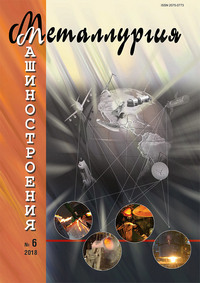
Abstracts:
Golubtsov V.A., Ryabchikov I.V., Bakin I.V., Mikhailov G.G. The role of alkaline earth metals in reducing the contamination of steel with non-metallic inclusions
Some methods allowing a reduction in contamination of steels with non-metallic inclusions including the role of the optimum ratio of Ca and Al in the modifiers used are considered. It is shown that the properties of steel can be significantly improved by treatment with Ca, Ba and Sr-bearing alloys.
Key words: Non-metallic inclusions, alkaline-earth metals, modification, steel deoxidation, oxide inclusions.
Korovin V.A., Romanov A.S., Sluzov P.A., Sedunov V.K. An effect of pseudo-ligature on properties of castings
It was proposed to use briquettes consisting of salt bath slimes and Al for modifying irons, which allows, by means of the melt desulfurization and degasation, to improve the physical and mechanical properties of the metal produced and to utilize anthropogenic wastes.
Key words: Modifying briquette, physical and mechanical properties of metal, salt bath slime, Al chips, wastes utilization.
Sidorov V.V., Petrov D.N., Kosenkov O.M., Filonova E.V. The reason of VH4L-VI supperalloy toughness decrease with waste application and means its increase
The reason of nickel base VH4L-VI supperalloy toughness decrease melted with AP648 alloy off-grade waste application received by chips remelting in air were considered. It was established that the reason of decrease appears the large carbides and their lines on grain boundary and these structure is inherited from AP648 alloy waste. The technological decision were developed including high temperature melt treatment application which allow to destroy an nonequilibrum carbon content complexes and maintain the forming of uniform dispersed structure carbide phase with favourable morphology so toughness of VH4L-VI alloy increases.
Key words: Nickel base VH4L-VI supperalloy, toughness, off-grade waste, high temperature
Romanyuk V.V., Nikitin V.I., Biktimirov R.M. Results of research of the quality of low-grade aluminum waste
In the article has been showed the results of research of the quality of low-grade aluminum waste with purpose to determine heredity factors, that impacts on quality of alloys gained from that waste. The microstructure of aluminum shavings from alloys AMg5 and D16, sawdust from alloy AK9ch, aluminum cans waste from alloy 3104 were obtained. The coefficient of purity and coefficient of contact with the atmosphere of waste were calculated.
Key words: Shavings, sawdust, aluminum cans, microstructure, scrap, coefficient of the contact with the atmosphere, heredity.
Amosov A.P., Latukhin E.I., Luts A.R., Titova Y.V., Maydan D.A. Application of SHS process for obtaining aluminum ceramic composite materials
The results of applying the process of selfpropagating high-temperature synthesis (SHS) to obtain aluminum ceramic composites, as compacted powder skeleton with a large volume content of the reinforcing ceramic phase (more than 30%) and cast matrix with a relatively small content of the ceramic phase (less than 30%).
Key words: Self-propagating high-temperature synthesis, aluminum, ceramic reinforcing phase, skeleton composites, cast composites.
Dmitriev E.A., Evstigneyev A.I., Odinokov V.I. Numerical investigation for simulation of the metal flow in the mold of a continuous casting unit
A mathematical model of the process of pouring steel into a rectangular crystallizer has been developed, which makes it possible to describe the kinematics of motion and the heat fluxes of liquid metal in it.
Key words: Numerical modeling, hydrodynamics, heat and mass transfer, liquid metal, casting, crystallizer.
Getman A.A. Comparison of properties of cast, welded and forged structural components
The results of a comparative analysis of mechanical properties of cast, welded and forged parts of the same configuration are given. It is shown that the parts obtained by the investment casting have better properties than welded and forged components.
Key words: Casting, forging, welded billet, structural components, mechanical properties, stress concentration, strength margin, frequency of failures.
Table of Content:
To the 100th anniversary of the birth. Boris Evgenievich Paton
Kolesnikova A.G., Ignatov A.V., Khilkova A.A. By the 150th anniversary of the "Engineering Technology" faculty of Bauman Moscow State Technical University
Adashkevich Yu.V. The 150th anniversary of the St. Petersburg machine building industry
Melting. Melt Treatment
Golubtsov V.A., Ryabchikov I.V., Bakin I.V., Mikhailov G.G. The role of alkaline earth metals in reducing the contamination of steel with non-metallic inclusions
Korovin V.A., Romanov A.S., Sluzov P.A., Sedunov V.K. An effect of pseudo-ligature on properties of castings
Modern Materials
Sidorov V.V., Petrov D.N., Kosenkov O.M., Filonova E.V. The reason of VH4L-VI supperalloy toughness decrease with waste application and means its increase
Romanyuk V.V., Nikitin V.I., Biktimirov R.M. Results of research of the quality of low-grade aluminum waste
XXI Century Technologies
Amosov A.P., Latukhin E.I., Luts A.R., Titova Y.V., Maydan D.A. Application of SHS process for obtaining aluminum ceramic composite materials
Dmitriev E.A., Evstigneyev A.I., Odinokov V.I. Numerical investigation for simulation of the metal flow in the mold of a continuous casting unit
Getman A.A. Comparison of properties of cast, welded and forged structural components
Information. Chronicle
|

